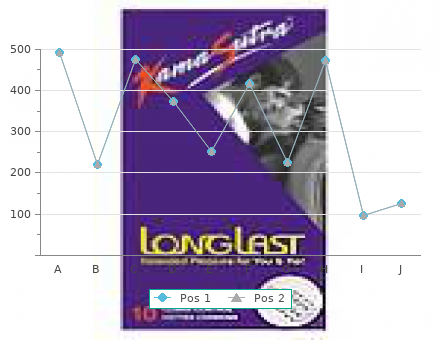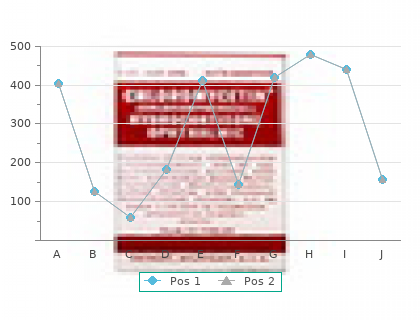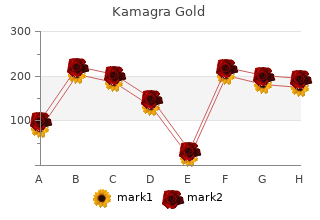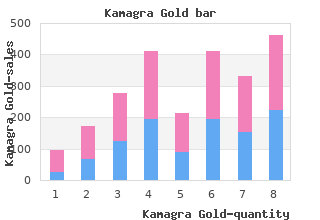Kamagra Gold
By V. Gorn. Cambridge College.
However cheap 100mg kamagra gold overnight delivery erectile dysfunction age graph, he should not be given Red cell type O A B AB type A serum (or type A whole blood) Possible genotypes OO AA or AO BB or BO AB because type A serum contains antibodies to Antibodies in serum Anti-A and B Anti-B Anti-A None type B antigens safe kamagra gold 100mg erectile dysfunction and premature ejaculation underlying causes and available treatments, which are present on his Frequency (in Caucasians) 45% 40% 10% 5% Can accept blood types O A, O B, O A, B, AB, O cells. CHAPTER 30 / SYNTHESIS OF GLYCOSIDES, LACTOSE, GLYCOPROTEINS AND GLYCOLIPIDS 553 The second important red blood cell group is the Rh group. It is important because one of its antigenic determinants, the D antigen, is a very potent immuno- gen, stimulating the production of a large number of antibodies. The unique carbohydrate composition of the glycoproteins that constitute the antigenic determinants on red blood cells in part contributes to the relative immuno- genicity of the A, B, and Rh (D) red blood cell groups in human blood. Tay-Sachs disease, the problem afflicting Jay Sakz, is an autosomal reces- sive disorder that is rare in the general population (1 in 300,000 births), but its prevalence in Jews of Eastern European extraction (who make up 90% of the Jewish population in the United States) is much higher (1 in 3,600 births). One in 28 Ashkenazi Jews carries this defective gene. Its presence can be discov- ered by measuring the tissue level of the protein produced by the gene (hex- osaminidase A) or by recombinant DNA techniques. Skin fibroblasts of concerned couples planning a family are frequently used for these tests. Carriers of the affected gene have a reduced but functional level of this enzyme that normally hydrolyzes a specific bond between an N-acetyl-D-galactosamine and a D-galactose residue in the polar head of the ganglioside. Enzyme replacement has met with little success because of the difficulties in getting the enzyme across the blood-brain barrier. BIOCHEMICAL COMMENTS Hexosaminidase A, the enzyme defective in Tay-Sachs disease, is actually composed of two subunits, an and a chain. The exact stoichiometry of the active enzyme is unknown, but it may be 2 2. The subunit is coded for by the HexA gene, whereas the subunit is coded for by the HexB gene. In Tay- Sachs disease, the subunit is defective, and hexosaminidase A activity is lost. However, the subunit can form active tetramers in the absence of the subunit, and this activity, named hexosaminidase B, which cleaves the glycolipid globoside, retains activity in children with Tay-Sachs disease. Thus, children with Tay-Sachs disease accumulate the ganglioside GM2, but not globoside (Fig. Mutation of the HexB gene, and production of a defective subunit, leads to inactivation of both hexosaminidase A and B activity. Both activities are lost because both activities require a functional subunit. The clinical course of this disease is similar to Tay-Sachs but with an accelerated timetable because of the initial accumulation of both GM2 and globo- side in the lysosomes. Sandhoff activator protein + hexosaminidase A (α2β2) Block in Sandhoff disease Block in Tay-Sachs disease GM2 ceramide glc gal NAcGal Sialic acid hexosaminidase A or B (β4) Block in Sandhoff disease Globoside ceramide glc gal gal NAcGal Fig. Substrate specificities of hexosaminidase A, B, and the function of the activator protein. Glc glucose; gal galactose; NAcGal N-acetylgalactosamine. Children were identified with Tay-Sachs symptoms, but when both hexosaminidase A and B activities were measured in a test tube, they were nor- mal. This disease, ultimately named Sandhoff activator disease, is caused by a mutation in a protein that is needed to activate hexosaminidase A activity. In the absence of the activator, hexosaminidase A activity is minimal, and GM2 initially accumulates in lysosomes. This mutation has no effect on hexosaminidase B activity. When a glycolipid cannot be degraded because of an enzymatic mutation, it accumulates in residual bodies (vacuoles that contain material that lysosomal enzymes cannot digest). Normal cells contain a small number of residual bodies, but in diseases of lysosomal enzymes, large numbers of residual bodies accumulate within the cell, eventually interfering with normal cell function. In 70% of the cases of Tay-Sachs disease in persons of Ashkenazai Jewish back- ground, exon 11 of the gene for the chain of hexosaminidase A contains a muta- tion. Suggested References Gravel RA, Kaback MM, Proia RL, Sandhoff K, et al.


Also discount 100 mg kamagra gold icd-9-cm code for erectile dysfunction, as these children are mobilized cheap kamagra gold 100 mg drugs for erectile dysfunction in nigeria, they may complain of a period of neuritic pain in the lower extremity, and several children have complained of areas of numbness. This neuritic pain is probably caused by the extensive nerve stretch that occurs when lumbar lordosis is corrected as the posterior neuronal structures undergo some lengthening. All patients have overcome this neuritic pain syndrome and the numbness has resolved; however, it occasionally requires up to 1 year. Spine 465 Complications of Spine Surgery Complications of posterior spinal fusion in children with CP are common. Most of these complications are relatively self-limiting and resolve with ap- propriate management. From an extensive review of 107 spinal fusions in children with CP, the best predictor for risk of complication is severity of the neurologic disability. The level of the neurologic involvement is defined based on a score that combines the ability to speak, walk, eat, presence of seizures, and intelligence. Based on assessing these five areas, there was such a strong correlation to neurologic disability that the presence of additional risk fac- tors such as tracheostomy, tracheal diversion, gastrostomy tubes, seizure drugs, or malnutrition were not correlated with additional risk. At this time, we believe the overriding risk factor for complications following spine surgery is the severity of the children’s neurologic disability. It is difficult to know how to use this information to counsel families, but physicians have to be honest with this risk. For families who want to aggressively pursue medical care, this risk is usually not a significant concern because the alternative of the child becoming bedfast is difficult for them to manage as well. Children or adolescents who have a spinal fusion for severe scoliosis usually also have many other multiple system problems. These problems, com- bined with the large magnitude of the surgical procedure, mean that these children are at risk for almost any medical problem that can be imagined. This discussion of complications will focus only on serious complications that have been encountered or that are encountered frequently. In reality, this covers almost every complication encountered in the 340 children with CP in whom we have done a spine fusion. Several notable areas are missing from this complication list, mainly thromboembolic disease. We have never seen pulmonary embolus or deep venous thrombosis in children or adolescents undergoing surgery. If thromboembolic disease was considered because of asymmetric swelling in the lower extremity, it has always been heterotopic ossification (discussed in Chapter 10) or a fracture. Therefore, the concern about thromboembolic disease rarely needs to be raised, and then only after every other alternative has been ruled out. Death: Mortality The most significant complication of spinal surgery is death. This is the only surgery in CP where there is a definite risk of mortality, although all surgery carries this risk at some level. There are no literature reviews that specifically evaluate the mortality rate, although series reporting mortality range from 31%31 to reports that include one death. In the last 12 years, we have performed 340 spinal fusions in children with CP and have had three deaths in the acute postoperative period. This result translates into a rate of slightly less than 1% mortality; however, these three deaths occurred in the most involved half of our children. Therefore, a more accurate risk is three deaths in 170 children for a rate of approximately 1. This is a reason- able rate based on conversations with other centers for this group of chil- dren who have the most severe neurologic involvement with no speech, no 466 Cerebral Palsy Management self-feeding, requiring gastroesophageal tube feeding, and who are fully de- pendent sitters. To maintain a low morbidity rate in these severely disabled children, high-volume experience and good protocols with multidisciplinary care are required. It is as important when comparing mortality rates as it is when comparing general complication rates to consider the severity of the children’s neurologic deficit. It is also important to do a careful case evalua- tion of all deaths, as often the death may have been due to a preventable cause and lessons can be learned. Specific causes of intraoperative death are usually bleeding that was not appropriately managed. With proper preparation and anesthesia, as well as surgical management, this should almost never happen, and every death due to excessive blood loss needs very careful attention to identify the causes of treatment failure.


Restoration of dopaminergic function by grafting of fetal rat substantia nigra to the caudate nucleus: long-term behavioral order 100 mg kamagra gold mastercard erectile dysfunction treatment after surgery, biochemical and histochemical studies order kamagra gold 100mg visa erectile dysfunction liver. Dunnett SB, Hernandez TD, Summerfield A, Jones JH, Arbuthott G. Graft- derived recovery from 6-OHDA lesions: specificity of ventral mesencephalic graft tissue. Biochemical and behavioral correction of MPTP-Parkinson-like syndrome by fetal cell transplantation. Survival and growth of fetal catecholamine neurons transplanted into the primate brain. Transplantation of embryonic dopaminergic neurons to the corpus striatum of marmosets rendered parkinsonian by 1-methyl-4-phenyl-1,2,3,6-tetrahydropyridine. Transplanted adrenal chromaffin cells in rat brain reduce lesion-induced rotational behavior. Intrastriatal adrenal medulla grafts in rats: long-term survival and behavioral effects. Stromberg I, Herrera-Marschitz M, Ungerstedt U, et al. Chronic implants of chromaffin tissue into the dopamine-denervated striatum. Effects of NGF on graft survival, fiber growth and rotational behavior. Adrenal medullary implants in the dopamine-denervated rat striatum. II, Acute behavior as a function of graft amount and location and its modulation by neuroleptics. Transplantation of adrenal medullary tissue to striatum in parkinsonism. Transplantation in Parkinson’s disease: two case of adrenal medullary grafts to the putamen. Open microsurgical autografts of adrenal medulla to right caudate nucleus in 2 patients with intractable Parkinson’s disease. The adrenal medullary transplant operation for Parkinson’s disease: Clinical observations in five patients. Adrenal medullary autograft transplantation into the striatum of patient’s with Parkinson’s disease. Adrenal medullary transplantation into the brain for treatment of Parkinson’s disease: clinical outcome and neurochemical studies. Multicenter study of autologous adrenal medullary transplantation to the corpus striatum in patients with advanced Parkinson’s disease. Autologous transplantation of adrenal medulla in Parkinson’s disease. Utilization of unilateral and bilateral stereotactically placed adrenomedullary-striatal autografts in par- kinsonian humans: rationale, techniques, and observations. Autopsy findings in a patient who had an adrenal-to-brain transplant for Parkinson’s disease. Putative chromaffin cell survival and enhanced host-derived TH-fiber innervation following a functional adrenal medulla autograft for Parkinson’s disease. Adrenal medulla grafts enhance recovery of striatal dopaminergic fibers. Transient behavioral recovery in hemiparkinsonian primates after adrenal medullary allografts. Adrenal medullary autografts into the basal ganglia of Cebus monkeys: injury-induced regeneration. Peripheral nerve provides NGF-like trophic support for grafted Rhesus adrenal chromaffin cells. Fetal nondopaminergic neural implants in parkinsonian primates: histochemical and behavioral studies. Evaluation of hemi- parkinsonism monkeys after adrenal medullary autografting or cavitation alone. Human fetal dopamine neurons grafted into the striatum in two patients with severe Parkinson’s disease. A detailed account of methodology and a 6-month follow-up.
Kamagra Gold
10 of 10 - Review by V. Gorn
Votes: 71 votes
Total customer reviews: 71 |



